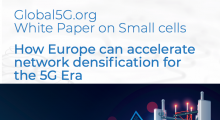GLOBAL5G.org Insights Report: Webinar on "How 5G Can Support Transformation in the Healthcare Industry"

The webinar took place the 15 May 2019, with the following agenda:
- Welcome & Introduction, Daniela Rao, Senior Director Research & Consulting, IDC
- The Role of 5G in Sustaining Healthcare Industry Digital Transformation, Silvia Piai, Health Insights Research Director, IDC
- How 5G can support Transformation in Healthcare industry (Jumoke Ogunbekun, StandICT.eu)
- 5G & Healthcare Transformation, Christoph Thümmler, Senior IEEE Member, Director, department of geriatric medicine and early Rehabilitation at Helios Park-Klinikum Leipzig, Director, Center of Care of the Elderly, Leipzig Region
- A new healthcare with new networks (Luca Ferraris, Head of Innovation, Marketing & Technology, Italtel-Exprivia)
- Questions & Answers
- Conclusions.
The webinar agenda was published on the Global5G project website and received 81 registrants.
The recorded webinar is available here
Key take-away messages
The digital revolution already apparent in other industries has yet to become mainstream in the health sector, with disruptions coming from improved patient engagement, connected care, unobtrusive monitoring, assisted living for people with chronic conditions, independent and active ageing, and robotic/remote surgery.
5G's technological advancements of faster speeds, lower latency, increased connection density, along with its capability to guarantee use case specific quality of service (QoS) via the network slicing functionality, are features that create the right connectivity environment for value based healthcare, in particular for those digital transformation use cases that will enable convenient access to care.
5G can accelerate precision, personalization and integration across the health value chain. IDC identifies 3 main areas of impact:
- One is certainly around the “connected patient” where 5G accelerates the personalization of care thanks to real-time monitoring of vital signs and more rapid and content rich interaction with clinicians independently from their location.
- Then the connected healthcare enterprise or connected hospital where the applications further expand beyond patient monitoring (as many devices experimented in Use cases Helios Park-Klinikum Leipzig presented in the webinar),and leverage the capability of 5G to support mission critical connectivity needs with higher capacity and lower latency as for example in remote robotic surgery.
- 5G will also bring benefits to the broader healthcare ecosystem supporting a more rapid cloud-based sharing of large datasets, as in the case of medical imaging, enhancing collaboration and boosting. With 5G the use of innovative user interfaces in augmented and virtual reality environments for clinical and educational purposes.
Considering this scenario, the "Feasibility Study on Communication Services for Critical Medical Applications" made by StandICT.eu proposed new potential requirements for critical medical applications supported by 5G communication services that are not already covered by existing 3GPP specifications.
5G is not only a solution to the digital divide and a way to achieve faster services, but a global enabler to rethink services and challenges, to design better solutions, to obtain smoother, quicker, more intelligent goals, to:
- Improve assistance and support in case of illnesses/accidents through remote monitoring of wearable sensors
- Implement predictive and personalized medicine services
- Location tracking can be extended to problematic patients.
Today, some medical skills are linked to the physical presence of doctors. Thanks to 5G, using advanced tele-diagnostic tools, they could be made available anywhere and at any time, allowing remote exams also via palpation. To achieve the High Fidelity required by these tele-medical applications, it is necessary to have latencies of the order of 1-10 ms and very reliable data transmission.
Tele-diagnosis, tele-surgery and tele-rehabilitation are the future applications of Tactile Internet in Healthcare enabled by 5G technologies
Conclusions
Value based healthcare requires greater data availability, granularity. It requires data to be real-time, to drive more evidence-based decisions, directly at the point of care. Healthcare information is characterized by distinct types of data in varying size and formats which place complex demands on the network in terms of bandwidth, data rate and latency among other factors.
5G's technological advancements of faster speeds, lower latency, increased connection density, along with its capability to guarantee use case specific quality of service (QoS) via the network slicing functionality, are features that create the right connectivity environment for value based healthcare, in particular for those digital transformation use cases that will enable convenient access to care.
5G can improve the healthcare enterprise mobility services that need to support clinical collaboration and communications that are richer in content and need a reliable infrastructure for mission critical applications and devices.
Also 5G lower latency, higher capacity and connectivity means it can better support video chat between patients and doctors, data transfer from clinical-grade wearables and medical devices, enabling faster more accurate remote diagnosis and remote monitoring.
But 5G will be a game changer especially for the provision of care outside the organization physical boundaries. Telehealth will benefit from 5G extended capabilities, to provide a broader range of high-quality remote care services. Telehealth market growth is driven by deployment of connected diagnostic and therapeutic devices to detect disease and monitor and maintain patient health, as well as fitness and wellness devices.



